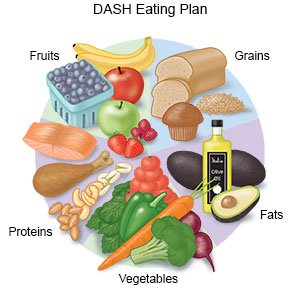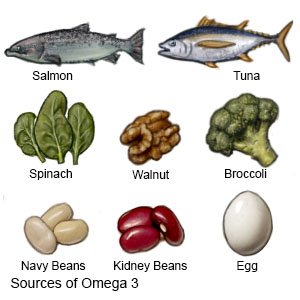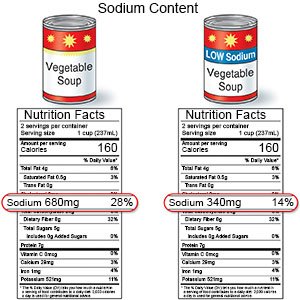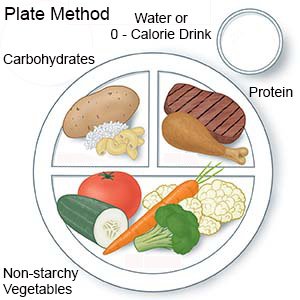Diabetes and Nutrition
Medically reviewed by Drugs.com. Last updated on Apr 6, 2025.
Why are nutrition plans important?
Nutrition plans help control blood sugar levels. They also help delay or prevent complications of diabetes, such as diabetic kidney disease.
How do I create a nutrition plan?
A dietitian will help you create a nutrition plan to meet your needs and your family's needs. Your dietitian may explain a plan such as the Dietary Approaches to Stop Hypertension (DASH) eating plan or the Mediterranean diet. The goal is for you to reach and maintain healthy weight, blood sugar, blood pressure, and lipid levels. You should meet with the dietitian at least 1 time each year. Your diabetes care provider may also recommend counseling to help you make nutrition changes. You will learn the following:
- How food affects your blood sugar levels
- How to create healthy eating habits and patterns
- How to make food choices based on your activity level, weight, and glucose levels
- How your favorite foods may fit into your plan
- Foods that contain carbohydrates (sugars and starches), including simple and complex carbohydrates
- How to keep track of all carbohydrates
- Correct portion sizes for each food
- Changes you can make to your plan if you get pregnant or are breastfeeding
 |
What are some tips to do until I meet with the dietitian?
- Eat the same number of meals each day. The goal is to keep your blood sugar levels in a healthy range throughout the day. Blood sugar levels may drop too low if you have received insulin and do not eat.
- Eat more high-fiber foods. Examples include fresh or frozen fruits and vegetables, whole-grain breads, and beans. Fiber helps control or lower blood sugar and cholesterol levels. Choose whole fruits instead of fruit juice as much as possible. Sugar may be added to juice, and fiber may be removed.

- Choose heart-healthy fats. Foods high in heart-healthy fats include olive oil, nuts, avocados, and fatty fish, such as salmon and tuna. Limit foods high in saturated fats such as red meat, full-fat dairy products, and soft margarine. Saturated fats can increase your risk for heart disease, increase bad cholesterol, and lower good cholesterol.

- Choose complex carbohydrates. Foods with complex carbohydrates include brown rice, whole-grain breads and cereals, and cooked beans. Foods with simple carbohydrates include white bread, white rice, most cold cereals, and snack foods. Your plan will include the amount of carbohydrate to have at one time or in a day. Your blood sugar level can get too high if you eat too much carbohydrate at one time. Blood sugar levels do not spike as high or drop as quickly with complex carbohydrates as with simple carbohydrates. Choose complex carbohydrates whenever possible.
- Have less sodium (salt). The risk for high blood pressure (BP) increases with high-sodium foods. Limit high-sodium foods, such as soy sauce, potato chips, and canned soup. Do not add salt to food you cook. Limit your use of table salt. Read labels to have no more than 2,300 milligrams of sodium in one day.

- Limit artificial sweeteners. These may be found in food or drinks, such as diet soft drinks or other low-calorie beverages. Artificial sweeteners are low in calories. They may help you lower your overall calories and carbohydrates. Artificial sweeteners do not have any nutrition. Eat whole foods and drink water as much as possible. Your plan may include beverages with artificial sweeteners for a short time. These can help you transition from high-sugar beverages to water.
- Use the plate method for each meal. This method can help you eat the right amount of carbohydrates and keep your blood sugar levels under control.
- Draw an imaginary line down the middle of a 9-inch dinner plate. On one side, draw another line to divide that section in half. Your plate will have one large section and 2 small sections.
- Fill the largest section with non-starchy vegetables. These include broccoli, spinach, cucumbers, peppers, cauliflower, and tomatoes.
- Add a carbohydrate to one of the small sections. Examples include pasta, rice, whole-grain bread, tortillas, corn, potatoes, and beans. Your plan may allow a serving of low-fat dairy or a small fruit as a carbohydrate.
- Add meat or another source of protein to the other small section. Examples include chicken or turkey without skin, fish, lean beef or pork, low-fat cheese, tofu, and eggs.
- Have a low-calorie or calorie-free drink with your meal. Examples include water or unsweetened tea or coffee.

What do I need to know if I choose to drink alcohol?
- Alcohol can cause health problems. Alcohol can cause hypoglycemia (very low blood sugar level), especially if you use insulin. Alcohol can cause high blood sugar and BP levels, and weight gain if you drink more than what is recommended.
- Hypoglycemia can happen hours after you drink alcohol. Check your blood sugar level for several hours after you drink alcohol. Have a source of fast-acting carbohydrates with you in case your level goes too low. You need immediate care if you have signs or symptoms of hypoglycemia, such as sweating, confusion, or fainting.
- Limit alcohol as directed. Your healthcare provider can tell you how many drinks are okay for you within 24 hours or within 1 week. Women 21 years or older and men 65 years or older should limit alcohol to 1 drink a day. Men aged 21 to 64 years should limit alcohol to 2 drinks a day. A drink of alcohol is 12 ounces of beer, 5 ounces of wine, or 1½ ounces of liquor.
- Always have food when you drink alcohol. Your blood sugar may fall to a low level if you drink when your stomach is empty.
Why is it important to maintain a healthy weight?
A healthy weight can help you control your diabetes. Ask your healthcare provider what a healthy weight is for you. Even a weight loss of 3% to 7% of excess body weight can help you manage diabetes. Your provider can help you create a weight-loss plan, if needed. For example, your goal may be to lose at least 5% of your extra weight in the first 6 months.
Call your local emergency number (911 in the US) if:
- You have any of the following signs of a heart attack:
- Squeezing, pressure, or pain in your chest
- You may also have any of the following:
- Discomfort or pain in your back, neck, jaw, stomach, or arm
- Shortness of breath
- Nausea or vomiting
- Lightheadedness or a sudden cold sweat
When should I seek immediate care?
- You have low blood sugar, and it doesn't improve with treatment. You may have trouble thinking, a pounding heartbeat, and sweating.
- You have high blood sugar above 240 mg/dL, and it does not go down within 15 minutes of treatment.
- You have ketones in your blood or urine.
- You have nausea or are vomiting and cannot keep any food or liquid down.
- You have blurred or double vision.
- You have fruity, sweet-smelling breath, or your breathing is shallow.
When should I call my doctor or diabetes care team provider?
- Your blood sugar levels are higher than your target goals.
- You often have low blood sugar levels.
- You have trouble coping with diabetes or feel anxious or depressed.
- You have questions or concerns about your condition or care.
Care Agreement
You have the right to help plan your care. Learn about your health condition and how it may be treated. Discuss treatment options with your healthcare providers to decide what care you want to receive. You always have the right to refuse treatment. The above information is an educational aid only. It is not intended as medical advice for individual conditions or treatments. Talk to your doctor, nurse or pharmacist before following any medical regimen to see if it is safe and effective for you.© Copyright Merative 2025 Information is for End User's use only and may not be sold, redistributed or otherwise used for commercial purposes.
Further information
Always consult your healthcare provider to ensure the information displayed on this page applies to your personal circumstances.
